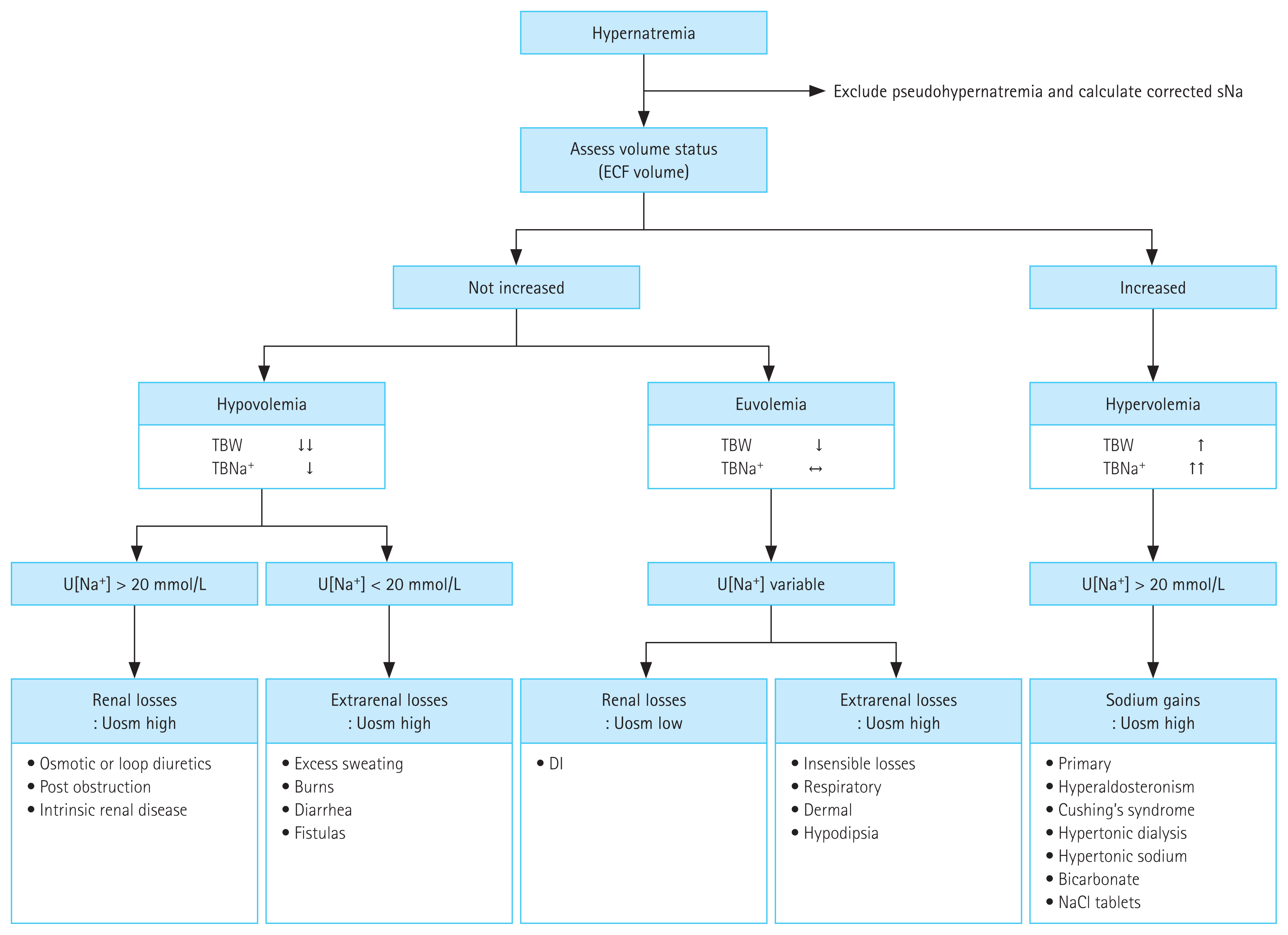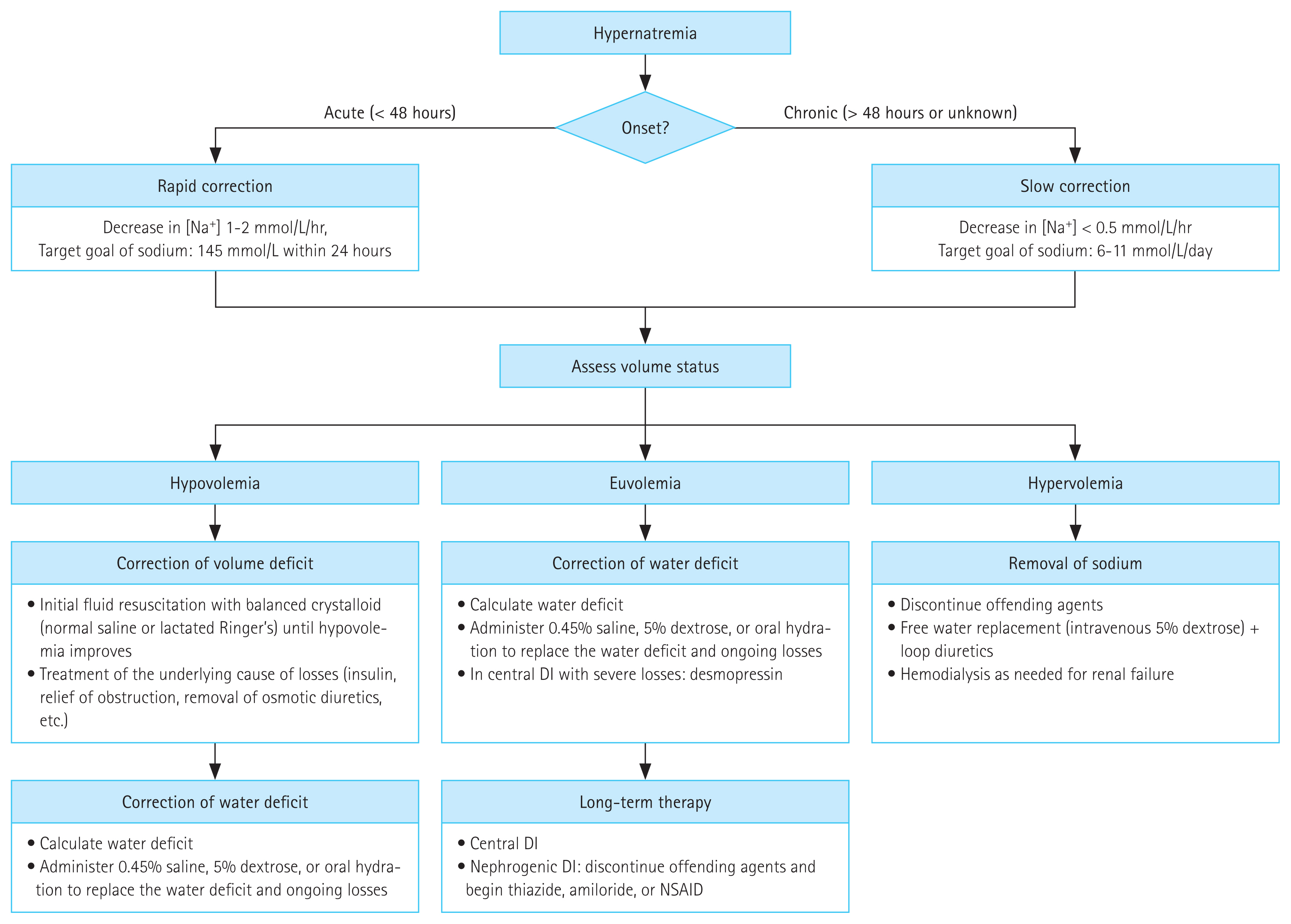1. Adrogue HJ, Madias NE. Hypernatremia. N Engl J Med 2000;342:1493–1499.


2. Liamis G, Filippatos TD, Elisaf MS. Evaluation and treatment of hypernatremia: a practical guide for physicians. Postgrad Med 2016;128:299–306.


6. Tsipotis E, Price LL, Jaber BL, Madias NE. Hospital-associated hypernatremia spectrum and clinical outcomes in an unselected cohort. Am J Med 2018;131:72–82.


9. Lindner G, Funk GC. Hypernatremia in critically ill patients. J Crit Care 2013;28:216.


10. Lindner G, Funk GC, Schwarz C, et al. Hypernatremia in the critically ill is an independent risk factor for mortality. Am J Kidney Dis 2007;50:952–957.


13. Muhsin SA, Mount DB. Diagnosis and treatment of hypernatremia. Best Pract Res Clin Endocrinol Metab 2016;30:189–203.


14. Lam NN, Minh NTN. Risk factors and outcome of hypernatremia amongst severe adult burn patients. Ann Burns Fire Disasters 2018;31:271–277.


20. Spasovski G, Vanholder R, Allolio B, et al. Clinical practice guideline on diagnosis and treatment of hyponatraemia. Eur J Endocrinol 2014;170:G1–G47.


22. Verbalis JG, Goldsmith SR, Greenberg A, et al. Diagnosis, evaluation, and treatment of hyponatremia: expert panel recommendations. Am J Med 2013;126(10 Suppl 1):S1–S42.


23. Singh AK. Hypernatremia. In: Mushlin SB, Greene HL, eds. Decision Making in Medicine. 3rd ed. Philadelphia (PA): Mosby, 2010;378–379.

25. Johnson R, Feehally J, Floege J, Tonelli M. Comprehensive Clinical Nephrology. 6th ed. Edinburgh (UK): Elsevier, 2018.
27. Mount DB. Fluid and electrolyte disturbances. In: Loscalzo J, Fauci A, Kasper D, Hauser S, Longo D, Jameson JL, eds. Harrison’s Principles of Internal Medicine. 21st ed. New York (NY): McGraw-Hill Education, 2022.
28. Sterns RH. Disorders of plasma sodium: causes, consequences, and correction. N Engl J Med 2015;372:55–65.


29. Strange K. Regulation of solute and water balance and cell volume in the central nervous system. J Am Soc Nephrol 1992;3:12–27.


30. Arieff AI, Guisado R. Effects on the central nervous system of hypernatremic and hyponatremic states. Kidney Int 1976;10:104–116.


33. Blum D, Brasseur D, Kahn A, Brachet E. Safe oral rehydration of hypertonic dehydration. J Pediatr Gastroenterol Nutr 1986;5:232–235.


35. Alshayeb HM, Showkat A, Babar F, Mangold T, Wall BM. Severe hypernatremia correction rate and mortality in hospitalized patients. Am J Med Sci 2011;341:356–360.

36. Sterns RH. Evidence for managing hypernatremia: is it just hyponatremia in reverse? Clin J Am Soc Nephrol 2019;14:645–647.


37. Lindner G, Schwarz C, Kneidinger N, Kramer L, Oberbauer R, Druml W. Can we really predict the change in serum sodium levels?: an analysis of currently proposed formulae in hypernatraemic patients. Nephrol Dial Transplant 2008;23:3501–3508.


39. Al-Absi A, Gosmanova EO, Wall BM. A clinical approach to the treatment of chronic hypernatremia. Am J Kidney Dis 2012;60:1032–1038.


42. Lindner G, Schwarz C, Funk GC. Osmotic diuresis due to urea as the cause of hypernatraemia in critically ill patients. Nephrol Dial Transplant 2012;27:962–967.


45. Kahn T. Hypernatremia with edema. Arch Intern Med 1999;159:93–98.


46. Harring TR, Deal NS, Kuo DC. Disorders of sodium and water balance. Emerg Med Clin North Am 2014;32:379–401.


47. Liamis G, Tsimihodimos V, Doumas M, Spyrou A, Bairaktari E, Elisaf M. Clinical and laboratory characteristics of hypernatraemia in an internal medicine clinic. Nephrol Dial Transplant 2008;23:136–143.


48. Shah MK, Workeneh B, Taffet GE. Hypernatremia in the geriatric population. Clin Interv Aging 2014;9:1987–1992.


49. Dimeski G, Morgan TJ, Presneill JJ, Venkatesh B. Disagreement between ion selective electrode direct and indirect sodium measurements: estimation of the problem in a tertiary referral hospital. J Crit Care 2012;27:326.


50. Filippatos TD, Liamis G, Christopoulou F, Elisaf MS. Ten common pitfalls in the evaluation of patients with hyponatremia. Eur J Intern Med 2016;29:22–25.


53. Hillier TA, Abbott RD, Barrett EJ. Hyponatremia: evaluating the correction factor for hyperglycemia. Am J Med 1999;106:399–403.


54. Katz MA. Hyperglycemia-induced hyponatremia: calculation of expected serum sodium depression. N Engl J Med 1973;289:843–844.


56. Mount DB. Azotemia and urinary abnormalities. In: Loscalzo J, Fauci A, Kasper D, Hauser S, Longo D, Jameson JL, eds. Harrison’s Principles of Internal Medicine. 21st ed. New York (NY): McGraw-Hill Education, 2022.
57. Robertson GL. Diabetes insipidus: differential diagnosis and management. Best Pract Res Clin Endocrinol Metab 2016;30:205–218.


58. Robertson GL, Bichet DG. Disorders of the neurohypophysis. In: Loscalzo J, Fauci A, Kasper D, Hauser S, Longo D, Jameson JL, eds. Harrison’s Principles of Internal Medicine. 21st ed. New York (NY): McGraw-Hill Education, 2022.
61. Rose BD, Post T, Post TW. Clinical Physiology of Acid-Base and Electrolyte Disorders. New York (NY): McGraw-Hill, 2001.
62. Fenske W, Refardt J, Chifu I, et al. A copeptin-based approach in the diagnosis of diabetes insipidus. N Engl J Med 2018;379:428–439.


68. Winzeler B, Cesana-Nigro N, Refardt J, et al. Arginine-stimulated copeptin measurements in the differential diagnosis of diabetes insipidus: a prospective diagnostic study. Lancet 2019;394:587–595.


71. Robertson GL. Diabetes insipidus. Endocrinol Metab Clin North Am 1995;24:549–572.


73. Milles JJ, Spruce B, Baylis PH. A comparison of diagnostic methods to differentiate diabetes insipidus from primary polyuria: a review of 21 patients. Acta Endocrinol (Copenh) 1983;104:410–416.


76. Braun MM, Barstow CH, Pyzocha NJ. Diagnosis and management of sodium disorders: hyponatremia and hypernatremia. Am Fam Physician 2015;91:299–307.

78. Agrawal V, Agarwal M, Joshi SR, Ghosh AK. Hyponatremia and hypernatremia: disorders of water balance. J Assoc Physicians India 2008;56:956–964.

80. Berl T. The Adrogue-Madias formula revisited. Clin J Am Soc Nephrol 2007;2:1098–1099.


81. Liamis G, Kalogirou M, Saugos V, Elisaf M. Therapeutic approach in patients with dysnatraemias. Nephrol Dial Transplant 2006;21:1564–1569.


82. Sterns RH, Silver SM. Salt and water: read the package insert. QJM 2003;96:549–552.


83. Shafiee MA, Bohn D, Hoorn EJ, Halperin ML. How to select optimal maintenance intravenous fluid therapy. QJM 2003;96:601–610.


84. Rose BD. New approach to disturbances in the plasma sodium concentration. Am J Med 1986;81:1033–1040.


85. Furst H, Hallows KR, Post J, et al. The urine/plasma electrolyte ratio: a predictive guide to water restriction. Am J Med Sci 2000;319:240–244.


89. Nguyen MK, Kurtz I. Correction of hypervolaemic hypernatraemia by inducing negative Na+ and K+ balance in excess of negative water balance: a new quantitative approach. Nephrol Dial Transplant 2008;23:2223–2227.


92. Van De Louw A, Shaffer C, Schaefer E. Early intensive care unit-acquired hypernatremia in severe sepsis patients receiving 0.9% saline fluid resuscitation. Acta Anaesthesiol Scand 2014;58:1007–1014.


93. Hoorn EJ, Betjes MG, Weigel J, Zietse R. Hypernatraemia in critically ill patients: too little water and too much salt. Nephrol Dial Transplant 2008;23:1562–1568.







 PDF Links
PDF Links PubReader
PubReader ePub Link
ePub Link Full text via DOI
Full text via DOI Download Citation
Download Citation Print
Print





